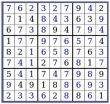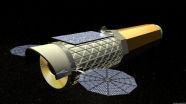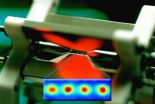(Press-News.org) At the Large Hadron Collider at CERN protons crash into each other at incredibly high energies in order to 'smash' the protons and to study the elementary particles of nature – including quarks. Quarks are found in each proton and are bound together by forces which cause all other known forces of nature to fade. To understand the effects of these strong forces between the quarks is one of the greatest challenges in modern particle physics. New theoretical results from the Niels Bohr Institute show that enormous quantities of random numbers can describe the way in which quarks 'swing' inside the protons. The results have been published in arXiv and will be published in the journal Physical Review Letters.
Just as we must subject ourselves, for example, to the laws of gravity and not just float around weightless, quarks in protons are also subject to the laws of physics. Quarks are one of the universe's smallest, known building blocks. Each proton inside the atomic nucleus is made up of three quarks and the forces between the quarks are so strong that they can never – under normal circumstances, escape the protons
Left- and right-handed quarks
The quarks combined charges give the proton its charge. But if you add up the masses of the quarks you do not get the mass of the proton. Instead, the mass of the proton is dependent on how the quarks swing. The oscillations of the quarks are also central for a variety of physical phenomena. That is why researchers have worked for years to find a theoretical method for describing the oscillations of quarks.
The two lightest quarks, 'up' and 'down' quarks, are so light that they can be regarded as massless in practice. There are two types of such massless quarks, which might be called left-handed and right-handed. The mathematical equation governing quarks' movements show that the left-handed quarks swing independently of the right-handed. But in spite of the equation being correct, the left-handed quarks love to 'swing' with the right-handed.
Spontaneous symmetry breaking
"Even though this sounds like a contradiction, it is actually a cornerstone of theoretical physics. The phenomenon is called spontaneous symmetry breaking and it is quite easy to illustrate", explains Kim Splittorff, Associate Professor and theoretical particle physicist at the Niels Bohr Institute, and gives an example: A dance floor is filled with people dancing to rhythmic music. The male dancers represent the left-handed quarks and the female dancers the right-handed quarks. All dance without dance partners and therefore all can dance around freely. Now the DJ puts on a slow dance and the dancers pair off. Suddenly, they cannot spin around freely by themselves. The male (left-handed) and female (right-handed) dancers can only spin around in pairs by agreeing on it. We say that the symmetry 'each person swings around, independent of all others' is broken into a different symmetry 'a pair can swing around, independent of other pairs'.
Similarly for quarks, it is the simple solution that the left-handed do not swing with the right-handed. But a more stabile solution is that they hold onto each other. This is spontaneous symmetry breaking.
Dance to random tones
"Over several years it became increasingly clear that the way in which the left-handed and right-handed quarks come together can be described using a massive quantities of random numbers. These random numbers are elements in a matrix, which one may think of as a Soduko filled in at random. In technical jargon these are called Random Matrices", explains Kim Splittorff, who has developed the new theory together with Poul Henrik Damgaard, Niels Bohr International Academy and Discovery Center and Jac Verbaarschot, Stony Brook, New York.
Even though random numbers are involved, what comes out is not entirely random. You could say that the equation that determines the oscillations of the quarks give rise to a dance determined by random notes. This description of quarks has proven to be extremely useful for researchers who are looking for a precise numerical description of the quarks inside a proton.
It requires some of the most advanced supercomputers in the world to make calculations about the quarks in a proton. The central question that the supercomputers are chewing on is how closely the left-handed and right-handed quarks 'dance' together. These calculations can also show why the quarks remain inside the protons.
One problem up until now has been that these numerical descriptions have to use an approximation to the 'real' equation for the quarks. Now the three researchers have shown how to correct for this so that the quarks in the numerical calculations also 'swing' correctly to random numbers.
New understanding of the data
"Using our results we can now describe the numerical calculations from large research groups at CERN and leading universities very accurately", says Kim Splittorff.
"What is new about our work is that not only the exact equation for quarks, but also the approximation, which researchers who work numerically have to use, can be described using random matrices. It is already extremely surprising that the exact equation shows that the quarks swing by random numbers. It is even more exciting that the approximation used for the equation has a completely analogous description. Having an accurate analytical description available for the numerical simulations is a powerful tool that provides an entirely new understanding of the numerical data. In particular, we can now measure very precisely how closely the right-handed and left-handed quarks are dancing", he says about the new perspectives in the world of particle physics.
INFORMATION:
Article in arXiv: http://arxiv.org/pdf/1001.2937v3
Kontact:
Kim Splittorff, Associate Professor, PhD in theoretical high energy physics.
Niels Bohr Institute, University of Copenhagen.
+45 3532-5359, split@nbi.dk
Quarks 'swing' to the tones of random numbers
2010-09-28
ELSE PRESS RELEASES FROM THIS DATE:
New sound recording device helps doctors study link between cough and reflux
2010-09-28
Coughing episodes are closely related to gastroesophageal reflux symptoms in patients who experience chronic cough, irrespective of other diagnoses, according to a new study in Gastroenterology, the official journal of the American Gastroenterological Association (AGA) Institute. Gastroesophageal reflux occurs when the acid contents of the stomach back up, or reflux, into the esophagus. This typically produces heartburn, a burning sensation below the sternum where your ribs come together.
"This is the first study to investigate the temporal relationship between cough ...
Gigantic mirror for X-radiation in outer space
2010-09-28
It is to become the largest X-ray telescope ever: The International X-Ray Observatory (IXO), which has been planned in a cooperation between NASA, ESA and Japan's Aerospace Exploration Agency JAXA, will be launched into space in 2021 and provide the world with brand new information about black holes and, thus, about the origin of the universe. Its dimensions are gigantic: The surface of the mirror alone, which is to capture, for example, the cosmic X-radiation of black holes, will be 1300 m2 in size. It will consist of commercially available silicon wafers with pores of ...
A study analyzes consumer protection laws in Spain
2010-09-28
The idea behind this research arose because of the huge disparity in existing laws regulating the area of consumer protection, which made it necessary, according to the researchers, to carry out a systematic study to develop a "general report" which would gather the common principles and regulations regarding the different laws governing consumer protection. During the time this research study was underway, the Texto Refundido de la Ley General para la Defensa de los Consumidores y Usuarios (Consolidated Text of General Law of Consumer Protection) (LGDCU) was published; ...
Quantum physics: Flavors of entanglement
2010-09-28
Entanglement is a fascinating property connecting quantum systems. Albert Einstein called it the "spooky action at a distance". This bizarre coupling can link particles, even if they are located on opposite sides of the galaxy. The strength of their connections is behind the promising quantum computers, the dream machines capable of quick and efficient computations.
The team lead by Rainer Blatt at the Institute of Experimental Physics of the University of Innsbruck has been working very successfully towards the realization of a quantum computer. In their recent study, ...
Medical profession needs special training to handle self-harm, says international review
2010-09-28
Healthcare professionals are still not receiving the appropriate training and support they need to help people who self-harm and this can result in negative attitudes and inadequate levels of care.
Those are the key findings of a research review carried out by mental health specialists from the University of Nottingham, UK, and published in the October issue of the Journal of Psychiatric and Mental Health Nursing.
Staff nurse Jo McHale and lecturer Anne Felton studied 19 papers from the UK, Australia, Sweden and Ireland, dating from 1998 to 2009 and covering the views ...
Spaniards choose stable jobs over ones related to their training
2010-09-28
"If you study, you are more likely to get a stable job, even if it doesn't have anything to do with your training". This is the thinking of workers living in Spain, according to a research study by the Pompeu Fabra University (UPF), which studied the level of over-education in Spain, Italy and France, and the relationship between this and temporary work.
"This can be explained by the high levels of employment insecurity in Spain in comparison with other European countries", Luis Ortiz, author of the study and a researcher at the UPF, tells SINC.
The study, which has ...
Novel mechanism discovered for communication between proteins that cause 'cell suicide'
2010-09-28
A recent study undertaken by investigators at five research centres, amongst which is the CSIC-University of the Basque Country Biophysics Unit, provides new clues for the understanding of the 'cell suicide' process. The research was published in the latest issue of the prestigious Cell journal.
Our bodies daily eliminate in a controlled manner more than 100 million defective cells, by means of a procedure known as 'cell suicide' or apoptosis. This is a highly complicated process, any imbalances thus arising causing serious diseases, prominent amongst which is cancer. ...
Red light regulates nectar secretion
2010-09-28
Flowering plants produce nectar to attract insect pollinators. Some plant species, such as Lima bean, also secrete nectar from so-called extrafloral nectaries to attract ants which in turn fend off herbivores. Scientists of the Max Planck Institute in Jena, Germany, have discovered that the production of extrafloral nectar is light dependent. They have shown that the plants are able not only to distinguish between day and night, but also to adapt their nectar secretion to current light conditions by using a special photoreceptor, the phytochrome. Phytochrome probably influences ...
Surgery found effective for patients with aggressive prostate cancer
2010-09-28
ROCHESTER, Minn. -- In one of the first studies to focus exclusively on the outcomes after treatment for patients with high-risk prostate cancer,(http://www.mayoclinic.org/prostate-cancer/) researchers have found that surgery provides high survival rates. Collaborating researchers at Mayo Clinic and Fox Chase Cancer Center (http://www.fccc.edu/) in Philadelphia discovered that patients with the most aggressive forms of prostate cancer who had radical prostatectomy procedures had a 10-year cancer-specific survival rate of 92 percent and an overall survival rate of 77 percent.
The ...
Computer model shows US vulnerable to MDR-TB epidemic
2010-09-28
While the U.S. has made great progress in the prevention and treatment of tuberculosis, the nation has become more susceptible to potential epidemics of multidrug-resistant tuberculosis (MDR-TB), according a study led by Johns Hopkins researchers. Computer simulations show that as TB prevalence falls, the risk for more extensive MDR-TB increases. In addition, the simulation also showed that higher detection of TB cases without proper treatment of cases also increased risk. The study findings are published in the September 22 edition of the journal PLoS ONE. An interactive ...




